
Santa Maria della Vittoria:
Rome’s Carmelite Church
by
Jim Collins
This past January we were two clueless pilgrims in Rome. My wife, Barbara, and I had joined a pilgrim group from St. Stephen’s Church in Sacramento for ten inspiring days exploring the churches of Rome. Since we are caretakers at the Carmelite Monastery in Georgetown, we maintained a certain bias towards all things Carmelite. We were excited to see a monument to St. Therese in St. Peter’s Basilica, but nothing prepared us for the Carmelite treasures at the church of Santa Maria della Vittoria (Saint Mary of Victory).

It all started with a visit to the Carmelite Generalate. With only an address supplied by Mother Mary Bethany we hopped on Rome’s Metro (subway) and then a bus to take us to Corzo d’Italia 38. There we hoped to take pictures of the headquarters and maybe even meet Fr. Luis Gamboa or Fr. Stephen Watson who had recently dined with us at our home during their visitation to the Georgetown Monastery. When we arrived, the Italian secretary, frustrated with my poor Italian, quickly called Fr. Stephen for help. In a few minutes he joined us in the parlor and showed us around the headquarters. We took pictures of rooms and paintings that would be special to our Carmelite community then we asked Fr. Stephen for directions to other Carmelite spots in Rome. Top on his list was Saint Mary of Victory Church. To be sure we wouldn’t end up lost in this unfamiliar part of Rome, he walked with us a few blocks and pointed down the street to the church. We thanked him and were on our way.
As we approached the church, we noticed a statue of St. Therese behind a black iron fence. Then we saw the ancient green doors with some Italian words above them, S. Maria della Vittoria.

As soon as we opened the doors, our eyes were drawn toward the main altar where a small painting was encircled by golden rays stretching magnificently in all directions. The tallest rays pointed vertically to a panoramic fresco on the dome of the apse. We were curious about this fresco of a victorious battle scene, so we sought out the souvenir shop where we found an English guide to the church.

In a few minutes we were no longer clueless in this church of Carmelite treasures. First of all, we learned about the fresco by Luigi Serra. It presents in colorful detail the Entry of the Miraculous Image into Prague, the same small painting surrounded by gold rays that we first saw when we entered the church. The miraculous image is a picture of St. Mary which had brought victory to the Catholic troops at the battle of White Mountain (near Prague) on November 8, 1620.

Battle of White Mountain
This famous battle took place when Protestantism was spreading throughout Europe threatening to displace the Catholic faith where it had been born through the blood of martyrs and nourished by the simple faith of the people for over a millennium. At stake in this battle was the Catholic faith in the area of Dalmatia (Czechoslovakia) particularly in the traditionally Catholic city of Prague. As the battle raged at Bílá hora (White Mountain in Czech) the Protestant army of 20,000 Bohemians and mercenaries under Christian of Anhalt had gained a strategic advantage and were about to rout the Catholic army of 25,000 men of the combined armies of Ferdinand II, Holy Roman Emperor under Karel Bonaventura Buquoy and of the Catholic League under Johan Tzerclaes, Count of Tilly. When all hope seemed lost the army chaplain, Ven. P. Domenico of Jesus and Mary, a discalced Carmelite, mounted a soldier’s horse and galloped around the battle field displaying around his neck an image of the Virgin in adoration of the Child which he had found in a Protestant castle where it had been disfigured, the eyes of all the figures except that of the Christ-child having been pierced.
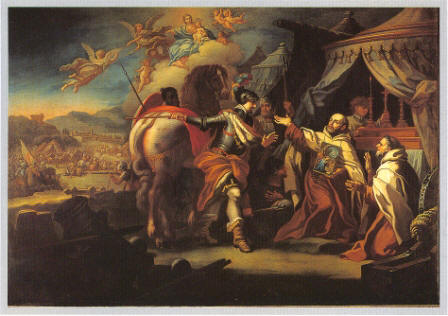
Soldier encourages Venerable Domenico to mount his horse
Vibrant rays of light emerged from the image as Domenico bravely rode the soldier’s horse during the battle. The enemy was shortly in complete disarray and forced into a hasty retreat. The victorious army marched in triumph to Prague displaying the miraculous image to all the faithful. Then on May 8, 1622, the image was brought to this church in Rome which is now called Santa Maria della Vittoria, or simply, la Vittoria.
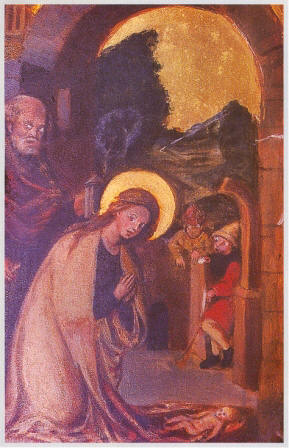
The Miraculous Image
With this information Barbara and I headed back to the main altar. Now we could appreciate the miraculous image and the fresco of the celebration in Prague and could offer prayers of thanksgiving for this victory of Mary in saving the faith in Prague and its surrounding area. Wanting to see more mementos of this miracle, we entered a large hall by the church where we saw four paintings of the battle of White Mountain, an imposing portrait of Ven. P. Domenico of Jesus and Mary, and a classic painting showing an armored soldier encouraging Ven. P. Domenico to mount his horse to display the miraculous image of St. Mary to his fellow soldiers in battle.
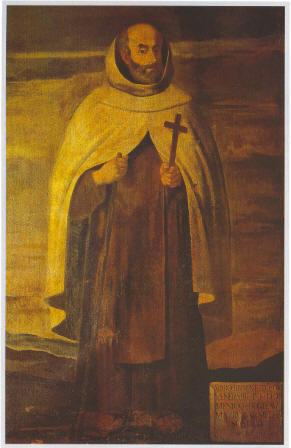
Venerable P. Domenico of Jesus and Mary
In a victorious spirit we marched back to the church to view its other treasures. Our eyes were drawn to the central cupola decorated with the Ascent of St. Paul to Heaven by Cerrini. This was an awesome fresco of St. Paul with the angels in heaven painted around an image of the Holy Spirit.
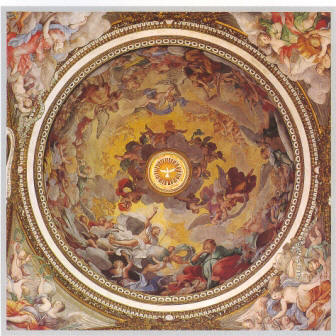
This was a remarkable fresco but how did this fit in this church of St. Mary of Victory? Once again our printed guide provided the answer. The church was built by the Discalced Carmelites between 1608 and 1620 on the site of a previous chapel dedicated to St. Paul the Apostle. Shortly after it was finished it became the depository of the miraculous picture of St. Mary of Victory. The church’s focus was forever changed to the Victory of St. Mary. Sadly, much of the church was destroyed by fire in 1833 including the small painting of Santa Maria della Vittoria which has been replaced with a masterful copy. With that question settled we began our tour of the eight chapels.
First we visited the chapel of St. Teresa of Jesus. Immediately we were transfixed by the Ecstasy of St. Teresa, Bernini’s exquisite sculpture, a masterpiece of Baroque art, considered by many to be one of the greatest sculptures of all time, and the jewel of this church. The details of the face of St. Theresa in ecstasy and seraphic face of the angel are inspired like the face of Mary in the Pieta.
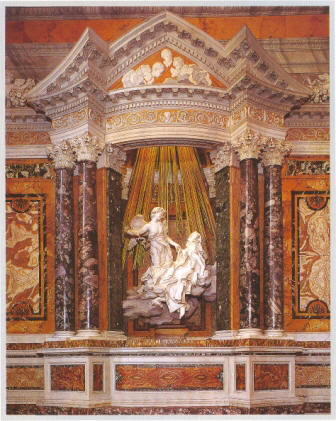

Ecstasy of St. Teresa, detail
We had just entered Carmelite heaven, but, after a short prayer, more treasures awaited. In the next side chapel we found Barbieri’s painting, The Most Holy Trinity, a seventeenth century masterpiece showing Christ in triumph surrounded by saints and angels with the Holy Spirit and the Father directly above him. On the other side of the Chapel of the Most Holy Trinity is the Chapel of St. John of the Cross. The placement was perfect showing how central the Trinity is to both St. Theresa and St. John. Nicholas Lorain’s, Jesus Appearing to the Saint, shows St. John with outstretched arms in ecstasy as he gazes up at Jesus surrounded by angels. We found it difficult to leave this part of Carmelite heaven but we had five more chapels to visit. Our next stop was the Chapel of St. Andrew which featured a large oil painting of St. Andrew kneeling and gazing toward heaven as he waited to be crucified on the X shaped cross.
Directly across the nave we wandered into the Chapel of Saint Therese of the Child Jesus. The spectacular painting, Saint of Roses, by Szoldatics drew us like a magnet toward the portrait of St. Therese throwing rose petals from her luminous place in heaven to earth.
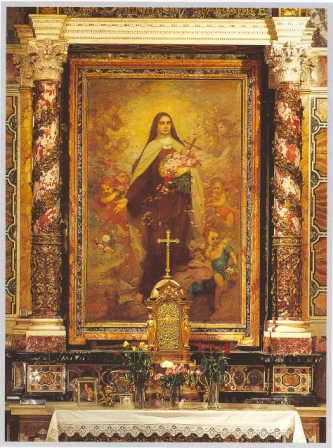
Our next stop was the Chapel of St. Francis of Assisi which features Zampieri’s (Domenichino’s) painting, the Virgin and St Francis. Here the Virgin Mary offers the infant Jesus to St. Francis. The last two chapels contained masterpieces of sculpture. First we entered the Chapel of the Madonna del Carmine where we marveled at Balzico’s sculpture, The Virgin giving the Scapular to St. Simon Stock. Mary looks down at St. Simon with loving eyes as she gives him the holy scapular.
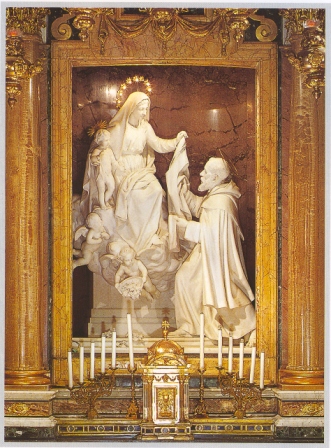
Leaving this reminder of another milestone in Carmelite history, we entered the Chapel of St. Joseph where we contemplated Guidi’s The Dream of St. Joseph, inspired by the Ecstasy of St. Teresa. Beneath the altar is a statue and relics of St. Victoria, virgin and Roman martyr.
As we exited the church down the central aisle, we looked up at the large vault fresco by Giuseppe and Adrea Orazi, the Triumph of Our Lady over the Heresies then caught a parting glimpse of the central cupola decorated with the Ascent of St. Paul to Heaven. Like a crown over the main doors we marveled at the ornate marble sculpture of the choir loft and the enormous display of pipes in Mattia De’ Rossi’s Cantoria, another baroque masterpiece. We could almost hear the thunder of the organ and the joyous choirs of ages past as we opened the doors and descended the steps to the streets of Rome.

Now we weren’t quite so clueless in Rome. But our next church was only a block away. In a few minutes we entered the Church of St. Susanna, considered the American church in Rome. But that’s another story with many more questions to be answered for a pair of clueless pilgrims.
See article in Carmelite Digest, Fall 2007 (www.carmelitedigest.org)